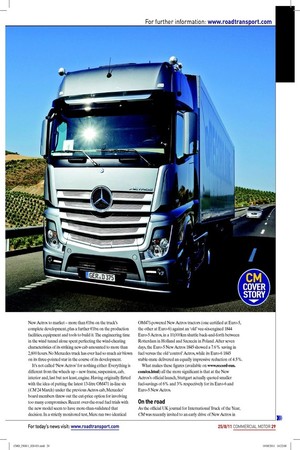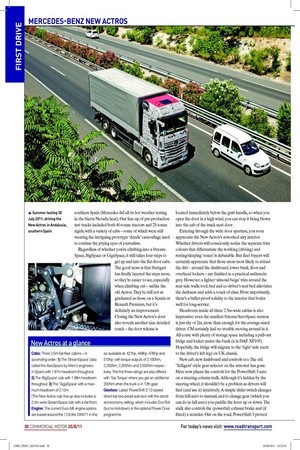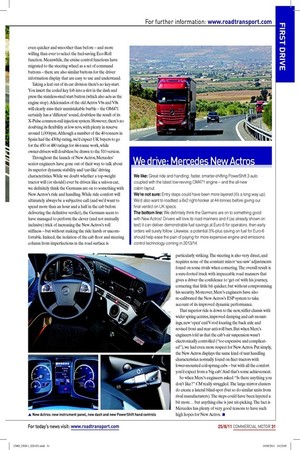olid as a rock
Page 23

Page 24

Page 25

Page 26

If you've noticed an error in this article please click here to report it so we can fix it.
As you’d expect, CM is the first UK truck magazine to drive Merc’s New Actros. So is Stuttgart right to be proud of its aLL-new heavyweight? We reckon it is...
Words: Brian Weatherley
There’s an inescapable air of self-belief swirling around the top-loor at Mercedes-Benz Trucks’ HQ. Not that the world’s largest CV manufacturer has ever lacked conidence. It’s just that with the recent arrival of New Actros, aspirations for Merc’s latest heavy truck range are running palpably high. Any minute now we imagine Andreas Renschler, Daimler AG board member and head of Daimler Trucks, running the Nelsonian signal up the company lagpole: “Stuttgart expects every truck salesman will do his duty!” What makes New Actros different from previous truck launches is that its arrival is being communicated in a rather, well, ‘un-Mercedes’ way. Witness Renschler’s own remark: “Let me put it simply... this truck just rocks!” Having driven the New Actros (of which more shortly) ‘rock’ is arguably the last thing it does. But we’re just being pedantic over Renschler’s choice of words...
Clearly, a shed-load of money has been spent on bringing New Actros to market – more than €1bn on the truck’s complete development, plus a further €1bn on the production facilities, equipment and tools to build it. The engineering time in the wind tunnel alone spent perfecting the wind-cheating characteristics of its striking new cab amounted to more than 2,600 hours. No Mercedes truck has ever had so much air blown on its three-pointed star in the course of its development.
It’s not called ‘New Actros’ for nothing either. Everything is different from the wheels up – new frame, suspension, cab, interior and, last but not least, engine. Having originally lirted with the idea of putting the latest 13-litre OM471 in-line six (CM 24 March) under the previous Actros cab, Mercedes’ board members threw out the cut-price option for involving too many compromises. Recent over-the-road fuel trials with the new model seem to have more-than-validated that decision. In a strictly monitored test, Merc ran two identical OM471-powered New Actros tractors (one certiied at Euro-5, the other at Euro-6) against an ‘old’ vee-six-engined 1844 Euro-5 Actros, in a 10,000km shuttle back-and-forth between Rotterdam in Holland and Szczecin in Poland. After seven days, the Euro-5 New Actros 1845 showed a 7.6% saving in fuel versus the old ‘control’ Actros, while its Euro-6 1845 stable-mate delivered an equally impressive reduction of 4.5%.
What makes these igures (available on www.record-run. com/en.html) all the more signiicant is that at the New Actros’s oficial launch, Stuttgart actually quoted smaller fuel-savings of 6% and 3% respectively for its Euro-6 and Euro-5 New Actros.
On the road
As the oficial UK journal for International Truck of the Year, CM was recently invited to an early drive of New Actros in southern Spain (Mercedes did all its hot weather testing in the Sierra Nevada heat). Our line-up of pre-production test trucks included both 40-tonne tractors and 25-tonne rigids, with a variety of cabs – some of which were still wearing the intriguing prototype ‘dazzle’ camoulage used to confuse the prying eyes of journalists.
Regardless of whether you’re climbing into a Stream Space, BigSpace or GigaSpace, it still takes four steps to get up and into the lat-loor cabs. The good news is that Stuttgart has inally layered the steps more, so they’re easier to see, especially when climbing out – unlike the old Actros. They’re still not as graduated as those on a Scania or Renault Premium, but it’s deinitely an improvement. Closing the New Actros’s door also reveals another nice detailed touch – the door release is located immediately below the grab handle, so when you open the door in a high wind, you can stop it being blown into the cab of the truck next door.
Entering through the wide door aperture, you soon appreciate the New Actros’s reworked airy interior. Whether drivers will consciously notice the separate trim colours that differentiate the working (driving) and resting/sleeping ‘zones’ is debatable. But leet buyers will certainly appreciate that those areas most likely to attract the dirt – around the dashboard, lower bunk, loor and overhead lockers – are inished in a practical anthracite grey. However, a lighter ‘almond beige’ trim around the rear side walls, roof, bed and co-driver’s seat bed alleviates the darkness and adds a touch of class. More importantly, there’s a bullet-proof solidity to the interior that bodes well for long-service.
Headroom inside all three 2.5m-wide cabins is also impressive: even the smallest Stream/AeroSpace version is just shy of 2m, more than enough for the average-sized driver. CM certainly had no trouble moving around in it. All come with plenty of storage space including a pull-out fridge and locker under the bunk (à la DAF XF105). Hopefully, the fridge will migrate to the ‘right’ side (next to the driver’s left leg) on UK chassis.
New cab, new dashboard and controls too. The old ‘Telligent’-style gear selector on the arm-rest has gone. Merc now places the controls for the PowerShift 3 auto on a steering column stalk. Although it’s hidden by the steering wheel, it shouldn’t be a problem as drivers will ind (and use it) intuitively. A simple slider switch changes from full-auto to manual, and to change gear (which you can do in full auto) you paddle the lever up or down. The stalk also controls the (powerful) exhaust brake and (if itted) a retarder. Out on the road, PowerShift 3 proved even quicker and smoother than before – and more willing than ever to select the fuel-saving Eco-Roll function. Meanwhile, the cruise control functions have migrated to the steering wheel as a set of command buttons – there are also similar buttons for the driver information display that are easy to use and understand.
Taking a leaf out of its car division there’s no key-start. You insert the coded key fob into a slot in the dash and press the stainless-steel start button (which also acts as the engine stop). Aicionados of the old Actros V6s and V8s will clearly miss their unmistakable burble – the OM471 certainly has a ‘different’ sound, doubtless the result of its X-Pulse common-rail injection system. However, there’s no doubting its lexibility at low revs, with plenty in reserve around 1,000rpm. Although a number of the 40-tonners in Spain had the 430hp rating, we’d expect UK buyers to go for the 450 or 480 ratings for 44-tonne work, while owner-drivers will doubtless be drawn to the 510 version.
Throughout the launch of New Actros, Mercedes’ senior engineers have gone out of their way to talk about its superior dynamic stability and ‘car-like’ driving characteristics. While we doubt whether a top-weight tractor will (or should) ever be driven like a saloon car, we deinitely think the Germans are on to something with New Actros’s ride and handling. While ride comfort will ultimately always be a subjective call (and we’d want to spend more than an hour and a half in the cab before delivering the deinitive verdict), the Germans seem to have managed to perform the clever (and not mutually inclusive) trick of increasing the New Actros’s roll stiffness – but without making the ride harsh or uncomfortable. Indeed, the isolation of the cab loor and steering column from imperfections in the road surface is particularly striking. The steering is also very direct, and requires none of the constant minor ‘see-saw’ adjustments found on some rivals when cornering. The overall result is a sure-footed truck with impeccable road manners that gives a driver the conidence to ‘get on’ with his journey, cornering that little bit quicker, but without compromising his security. Moreover, Merc’s engineers have also re-calibrated the New Actros’s ESP system to take account of its improved dynamic performance.
That superior ride is down to the new, stiffer chassis with wider spring centres, improved damping and cab mountings, new ‘open’ end V-rod locating the back axle and revised front and rear anti-roll bars. But when Merc’s engineers told us that the cab’s air suspension wasn’t electronically controlled (“too expensive and complicated”), we had even more respect for New Actros. Put simply, the New Actros displays the same kind of taut handling characteristics normally found on leet tractors with lower-mounted coil-sprung cabs – but with all the comfort you’d expect from a ‘big cab’. And that’s some achievement.
So when Merc’s engineers asked: “Is there anything you don’t like?” CM really struggled. The large mirror clusters do create a lateral blind-spot (but so do similar units from rival manufacturers). The steps could have been layered a bit more... but anything else is just nit-picking. The fact is Mercedes has plenty of very good reasons to have such high hopes for New Actros. ■














































